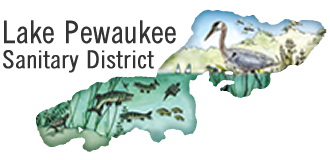The lake crews are in full swing for the 2012 season and the aquatic plants started growing heavy as early as April this year. A light winter and lack of snow cover and thin ice kept the aquatic plants healthy and less stressed out. The non-native Eurasian milfoil was reaching for the surface in the shallow bays and hitting the surface already in May. With this sunny hot weather the filamentous algae seems to be blooming along the shores between the piers and on the aquatic plants themselves. This helps choke out the plant growth where the weeds are trying to reach the surface. While we are putting the crews in full force, we can’t emphasize enough how much more efficient we can remove the weeds if the lake property owners participate in the pile pick ups on Mondays and Fridays. The Lake Pewaukee Sanitary District started this process several years ago and to date, other Lake Districts have been following our lead. This process takes teamwork and we realize this does take effort from you. We want you to know that this effort goes farther than you think. Weeds you pile up help us remove even more Eurasian milfoil fragments from the lake and prohibit their reestablishment. If your weeds are piled we can move around the lake quicker, pick up more weeds faster and it allows us to clean more shoreline and harvest more milfoil.
Here’s a question I have heard from the lake property owners –“Why is there a big mat of weeds out in the bay and why is nobody is cutting it?”
The number one priority is harvesting the aquatic plants along the outside of the piers to allow access around the whole lake and to get boats in and out from shore.
The second priority is to cut access lanes through the heavy mats that tend to develop in the shallow bays around the lake. Cutting access lanes allows boat traffic to get in and out as well as provide “predator channels” for game fish to feed in. The pan fish in Pewaukee Lake have become slightly “stunted” in growth due to the large population and the heavy aquatic plant growth that allows gives them a place to hide in. These “predator channels” will help address that issue as well as allow the lake users to pass through the otherwise inaccessible areas. Our goal is to make these channels wide enough for boat traffic in both directions at the same time and keep these free of aquatic plants while still maintaining priority number one. All this takes a lot of time and staff. At the same time we also need to keep the shorelines free of the floating plants which can clog up boat lifts, make it difficult to fish off the piers and swimming undesirable.
To date with the heavy growth we are keeping up with the floaters and keeping the channels free for traffic. The extra benefit of channels are the simple fact that people use them and it really cuts down on the amount of floaters that are created from prop shop. Eliminating the floaters pleases the skiers, boaters, wave runners, swimmers and fisherman and it allows us more time to cut aquatic plants.
The third priority is topping off the large mats. Most of the heavy mats are in shallow areas and bays. These areas typically include Buena Vista (Crystal Springs/Maple Avenue), Glen Cove, Auer Park, Starkey Bay, Peninsula Bay, Woodland, Peterson, Kopmier and Parkside. Most of these locations are in areas where soils are very silty which make up ideal conditions for aquatic plant growth. Remember most of these areas were swamp land or very shallow before the dam was installed and the lake was flooded. Please understand these areas will never be a “gravel bottom blue swimming pool” free of weeds and silt. However as time permits and the lake users continue to use the channels, we can continue to minimize the size of the mats as time permits. Removing the heavy mats will help improve access, it will help the fisheries and it helps the aesthetic appearance of the lake, it’s simply a matter of time, money and equipment. Let’s use cutting out the shallow inside of Peninsula Bay for example: First of all we are not permitted to cut right to the bottom. A short stand of aquatic plant is required to hold the sediment together with the root systems as well as provide a minimal amount of cover for the fish and critters. Second even if we were permitted to cut to the bottom, the harvester’s blades are on an angle and as you move forward the plants tend to bend over so you really end up leaving 12 inches of plant material anyway. The bays typically have large rocks that are difficult to see so damaging the harvesters becomes a high risk. Once damaged, they are shut down and in for maintenance which means they are not available for keeping the piers and lanes open. Now factor in the aquatic plant growth rate. You managed to cut 12” of plant out and during this peak time of growth, how long is it before the aquatic plants are back to the surface? A week? If we used chemicals and it killed the weeds and created sediment, how deep will the bay be in 20 years? If we did this along Woodland, Peninsula and Kopmier it may become inaccessible all together with our large heavy harvesting equipment. It could possibly become a large stand of cattails instead of the water and aquatic plants you see today.
Lastly if we did want to move forward with crews to try to accomplish this during peak growth years it would take an increase in equipment, maintenance and labor which leads us to budgets. Lake property owners in the bad areas may be willing to pay extra but lake property owners in areas with little growth may not. If we special assess the people in the bad areas and then spend more time there, the people in the good areas may think they are not getting their normal service. If we increase or double the tax levy, people that are not on the lake think that is unfair. There will be lots to talk about in the future as we work towards developing a new Lake Management Plan for this constantly changing ecosystem we have on Pewaukee Lake.
Lake Equipment reminder –
The Harvesters (weed cutters) are Yellow. They are cutting on Mondays, Tuesdays, Wednesdays and Thursdays. Typically “as a rule of thumb” the harvesters do not cut on Fridays so we can focus on cleaning up the cut weeds (the floaters) to prep the lake for the recreational users over the weekend whether you are sailing, fishing, skiing or just on a scenic cruise. Once and a while if it’s too windy for shore clean-up or we are caught up on cleaning up floaters, we run the harvesters in a calm bay to keep working at removing as many aquatic plants as possible.
The Shore barges (weed pick up – floaters and shorelines) are Orange. They are out everyday, picking up floating weeds and weeds along the shoreline.
The Transporters are Blue. They are out everyday and they are used for unloading Harvesters and Shore barges to transport the weeds across the lake. They hook up to the conveyor which loads the weeds into Big Red (the big red dump truck). The Transporters are also heavily utilized in pile pickups on Mondays and Fridays.
All equipment and lake staff are scheduled daily based on weed status and wind directions. The schedules are always subject to weather conditions. Old Mother Nature can shut us down at any time. While we will work in rain and fairly windy conditions, we pull the crews off the lake when the winds get too strong and/or lightning is observed in the area.
Remember if you want your shoreline looking mint for the Holiday weekend (or any weekend), help us, help you, by stacking the weeds in piles for Fridays pile pick up. Remember to stack the weeds where they are accessible for pick up with our large Shore barge or transporters.
[July 2012 LPSD Newsletter]







